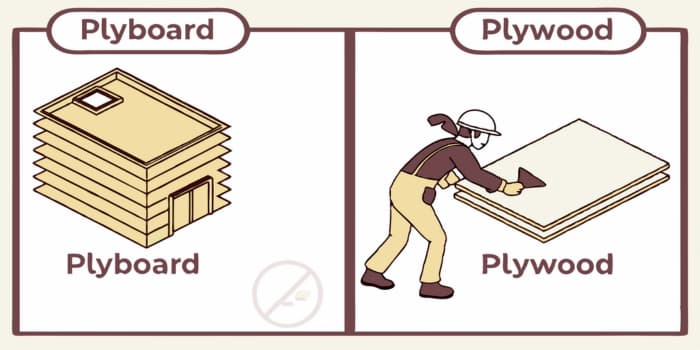
When embarking on a woodworking or home improvement project, one of the most critical decisions you’ll face is selecting the right material. For many, the choice comes down to plyboard vs plywood. Though their names sound similar, these materials are distinct in composition, performance, and application. Understanding the key differences can help you make an informed decision, saving you time and money in the long run.
What is Plyboard?
Plyboard, sometimes referred to as blockboard, is an engineered wood product made by sandwiching a core of wooden strips between two thin layers of veneer. These strips are typically made from softwood or hardwood and are glued together under high pressure. The outer veneers give plyboard a smooth finish, making it ideal for specific applications.
Features of Plyboard:
- Composed of wooden strips placed edge-to-edge.
- Sandwiched between layers of veneer.
- Lightweight and easy to handle.
- Typically available in standard sizes and thicknesses.
What is Plywood?
Plywood is another type of engineered wood product. It is made by gluing together multiple layers (or plies) of thin wood veneers, with the grain of each layer oriented perpendicular to the one below it. This cross-grain structure provides plywood with its signature strength and durability.
Features of Plywood:
- Composed of multiple thin veneers glued together.
- Grain orientation alternates for added strength.
- Known for its durability and flexibility.
- Available in a wide variety of grades and finishes.
Plyboard vs Plywood: A Side-by-Side Comparison
Below is a table to help you quickly understand the main differences between plyboard and plywood:
| Feature | Plyboard | Plywood |
|---|---|---|
| Composition | Wooden strips core with veneer layers | Thin wood veneers glued together |
| Strength | Moderate, ideal for lightweight use | High, suitable for heavy-duty tasks |
| Weight | Lighter | Heavier |
| Flexibility | Less flexible, prone to breaking | Highly flexible and durable |
| Water Resistance | Lower resistance to moisture | Higher resistance to moisture |
| Cost | More affordable | Generally more expensive |
| Common Uses | Partitions, shelves, and furniture | Flooring, walls, and structural work |
Advantages and Disadvantages of Plyboard
Advantages:
- Lightweight: Easy to handle and transport.
- Cost-Effective: More affordable compared to plywood.
- Ideal for Indoor Use: Great for furniture like shelves and partitions.
Disadvantages:
- Lower Water Resistance: Not suitable for areas exposed to moisture.
- Weaker Structure: Prone to bending or breaking under heavy loads.
- Limited Applications: Not suitable for high-strength requirements.
Advantages and Disadvantages of Plywood
Advantages:
- Durable and Strong: Excellent load-bearing capacity.
- Water-Resistant Options: Marine-grade plywood can withstand moisture.
- Versatile: Suitable for various applications, from furniture to construction.
Disadvantages:
- Heavier: More challenging to handle compared to plyboard.
- Higher Cost: Comes with a premium price tag.
- Splintering: Can splinter along the edges if not cut properly.
Applications of Plyboard and Plywood
Where Plyboard is Used:
- Furniture: Ideal for lightweight furniture such as cupboards, shelves, and partitions.
- Interior Walls: Commonly used in non-load-bearing interior walls.
- Ceilings: Works well for false ceilings.
Where Plywood is Used:
- Construction: Suitable for structural applications like roofing and flooring.
- Outdoor Furniture: Marine plywood is excellent for outdoor furniture due to its water resistance.
- Cabinetry: Preferred for high-quality cabinets and drawers.
Factors to Consider When Choosing Between Plyboard and Plywood
1. Strength and Durability
Plywood is inherently stronger due to its cross-grain structure, making it suitable for load-bearing applications. Plyboard, on the other hand, is weaker and best suited for lighter tasks.
2. Weight
If weight is a concern, plyboard is the better choice due to its lightweight construction. This makes it easier to transport and install.
3. Water Resistance
Plywood, especially marine grade, offers better resistance to moisture compared to plyboard. For areas prone to humidity, such as kitchens and bathrooms, plywood is the safer bet.
4. Cost
Plyboard is more budget-friendly and can be a good choice for projects with cost constraints. Plywood, while more expensive, often provides better long-term value.
5. Application
Consider the purpose of your project. For lightweight furniture and partitions, plyboard suffices. For structural work or outdoor use, plywood is more suitable.
Tips for Working with Plyboard and Plywood
- Cutting: Use sharp tools to avoid splintering.
- Finishing: Always sand the surface for a smooth finish before painting or polishing.
- Moisture Protection: Apply a sealant if the material is exposed to moisture.
- Storage: Store in a dry area to prevent warping.
Conclusion
When it comes to plyboard vs plywood, the choice ultimately depends on your project’s specific needs. Plyboard is a lightweight, affordable option suitable for indoor furniture and partitions, while plywood offers superior strength, durability, and water resistance, making it ideal for construction and outdoor applications. By understanding their differences and weighing the pros and cons, you can select the material that best suits your requirements and ensures a successful project.
Can Plyboard Be Used For Outdoor Furniture?
Plyboard is not ideal for outdoor furniture as it has low moisture resistance. Over time, exposure to water can weaken its structure and cause delamination.
Is Plywood Stronger Than Plyboard?
Yes, plywood is generally stronger than plyboard due to its cross-grain construction, which provides greater durability and load-bearing capacity.
Which Is More Affordable: Plyboard Or Plywood?
Plyboard is more affordable than plywood, making it a cost-effective choice for indoor furniture and partitions.
What Type Of Plywood Is Best For Moisture-Prone Areas?
Marine-grade plywood is the best option for areas exposed to moisture. It is specially treated to resist water damage.
Can Plyboard And Plywood Be Painted?
Yes, both plyboard and plywood can be painted. However, it is recommended to sand the surface and apply a primer for better results.